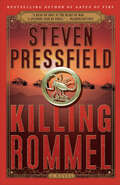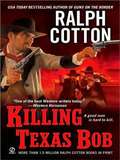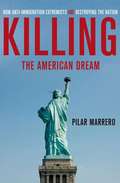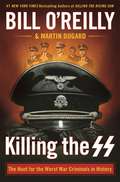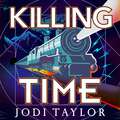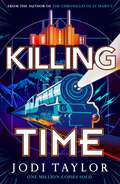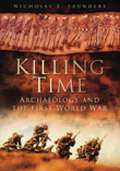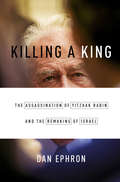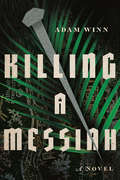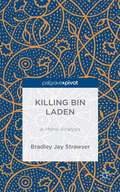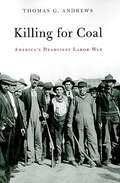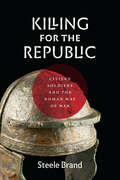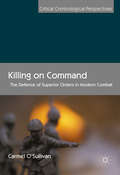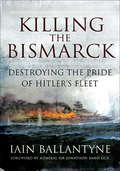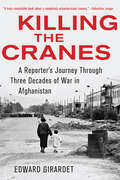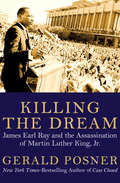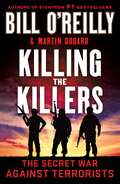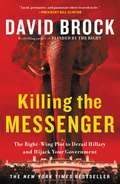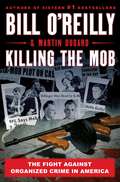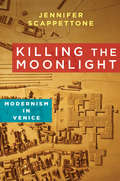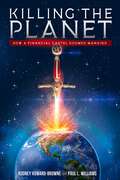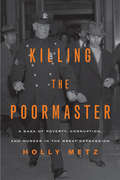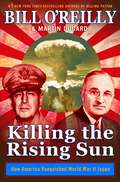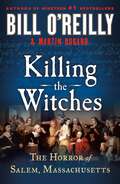- Table View
- List View
Killing Rommel: A Novel
by Steven PressfieldBONUS: This eBook edition contains an excerpt from THE PROFESSION: A Thriller by Steven Pressfield. On sale June 2011.Steven Pressfield’s quintet of acclaimed, bestselling novels of ancient warfare— Gates of Fire, Tides of War, Last of the Amazons, The Virtues of Wa,r and The Afghan Campaign— have earned him a reputation as a master chronicler of military history, a supremely literate and engaging storyteller, and an author with acute insight into the minds of men in battle. In Killing Rommel Pressfield extends his talents to the modern world with a WWII tale based on the real-life exploits of the Long Range Desert Group, an elite British special forces unit that took on the German Afrika Korps and its legendary commander, Field Marshal Erwin Rommel, "the Desert Fox." Autumn 1942. Hitler’s legions have swept across Europe; France has fallen; Churchill and the English are isolated on their island. In North Africa, Rommel and his Panzers have routed the British Eighth Army and stand poised to overrun Egypt, Suez, and the oilfields of the Middle East. With the outcome of the war hanging in the balance, the British hatch a desperate plan—send a small, highly mobile, and heavily armed force behind German lines to strike the blow that will stop the Afrika Korps in its tracks. Narrated from the point of view of a young lieutenant, Killing Rommel brings to life the flair, agility, and daring of this extraordinary secret unit, the Long Range Desert Group. Stealthy and lethal as the scorpion that serves as their insignia, they live by their motto: Non Vi Sed Arte—Not by Strength, by Guile as they gather intelligence, set up ambushes, and execute raids. Killing Rommel chronicles the tactics, weaponry, and specialized skills needed for combat, under extreme desert conditions. And it captures the camaraderie of this “band of brothers” as they perform the acts of courage and cunning crucial to the Allies’ victory in North Africa. As in all of his previous novels, Pressfield powerfully renders the drama and intensity of warfare, the bonds of men in close combat, and the surprising human emotions and frailties that come into play on the battlefield. A vivid and authoritative depiction of the desert war, Killing Rommel brilliantly dramatizes an aspect of World War II that hasn’t been in the limelight since Patton. Combining scrupulous historical detail and accuracy with remarkable narrative momentum, this galvanizing novel heralds Pressfield’s gift for bringing more recent history to life.
Killing Texas Bob
by Ralph CottonArizona Ranger Sam Burrack is on the trail of Texas Bob Krey, wanted for the murder of a judge's brother. But it turns out the judge isn't the most law-abiding man himself. . .
Killing The American Dream: How Anti-immigration Extremists Are Destroying The Nation
by Pilar MarreroAs the US deports record numbers of illegal immigrants and local and state governments scramble to pass laws resembling dystopian police states where anyone can be questioned and neighbors are encouraged to report on one another, violent anti-immigration rhetoric is growing across the nation. Against this tide of hysteria, Pilar Marrero reveals how damaging this rise in malice toward immigrants is not only to the individuals, but to our country as a whole. Marrero explores the rise in hate groups and violence targeting the foreign-born from the 1986 Immigration Act to the increasing legislative madness of laws like Arizona's SB1070 which allows law officers to demand documentation from any individual with "reasonable suspicion" of citizenship, essentially encouraging states and municipalities to form their own self-contained nation-states devoid of immigrants. Assessing the current status quo of immigration, Marrero reveals the economic drain these ardent anti-immigration policies have as they deplete the nation of an educated work force, undermine efforts to stabilize tax bases and social security, and turn the American Dream from a time honored hallmark of the nation into an unattainable fantasy for all immigrants of the present and future.
Killing The SS: The Hunt for the Worst War Criminals in History (Bill O'Reilly's Killing Ser.)
by Bill O'Reilly Martin DugardConfronting Nazi evil is the subject of the latest installment in the mega-bestselling Killing series <P><P>As the true horrors of the Third Reich began to be exposed immediately after World War II, the Nazi war criminals who committed genocide went on the run. A few were swiftly caught, including the notorious SS leader, Heinrich Himmler. Others, however, evaded capture through a sophisticated Nazi organization designed to hide them. Among those war criminals were Josef Mengele, the “Angel of Death” who performed hideous medical experiments at Auschwitz; Martin Bormann, Hitler’s brutal personal secretary; Klaus Barbie, the cruel "Butcher of Lyon"; and perhaps the most awful Nazi of all: Adolf Eichmann. <P><P>Killing the SS is the epic saga of the espionage and daring waged by self-styled "Nazi hunters." This determined and disparate group included a French husband and wife team, an American lawyer who served in the army on D-Day, a German prosecutor who had signed an oath to the Nazi Party, Israeli Mossad agents, and a death camp survivor. Over decades, these men and women scoured the world, tracking down the SS fugitives and bringing them to justice, which often meant death. <P><P>Written in the fast-paced style of the Killing series, Killing the SS will educate and stun the reader. <P><P>The final chapter is truly shocking.
Killing Time (The Time Police #5)
by Jodi TaylorTIME POLICE AUDIOBOOK 5: The new Time Police adventure from the million-copy bestselling author of THE CHRONICLES OF ST MARY'S.'Jodi Taylor is quite simply the Queen of Time' C. K. MCDONNELLFrom the million-copy bestselling author of THE CHRONICLES OF ST MARY'S.A ghost train, lost in Time, hurtles through the night...Two members of Team 236 are trapped on board. Not ideal under any circumstances but catastrophic when they're at each other's throats.Hot on their heels, but never quite able to catch up, can Lt Grint and his team overcome all obstacles in their way and save their fellow officers before the train disappears for good?Nor is TPHQ without its own problems as Matthew risks his sanity to track them through the Time Map. And a Mikey-experiment goes horribly wrong, exposing something better left concealed for all Time. What are the Time Police hiding?And what will they do to keep their secret?AUDIOBOOK 5 IN THE TIME POLICE SERIESFOR FANS OF TERRY PRATCHETT, THE THURSDAY MURDER CLUB AND DOCTOR WHO Readers and listeners love the Time Police:'This got five stars only because I couldn't give it six!''I don't think I've ever laughed out loud so much reading a book''A new Jodi Taylor book is something I always get excited about'(P)2024 Headline Publishing Group Ltd
Killing Time (The Time Police #5)
by Jodi Taylor'Jodi Taylor is quite simply the Queen of Time' C. K. MCDONNELLFrom the million-copy bestselling author of THE CHRONICLES OF ST MARY'S.A ghost train, lost in Time, hurtles through the night...Two members of Team 236 are trapped on board. Not ideal under any circumstances but catastrophic when they're at each other's throats.Hot on their heels, but never quite able to catch up, can Lt Grint and his team overcome all obstacles in their way and save their fellow officers before the train disappears for good?Nor is TPHQ without its own problems as Matthew risks his sanity to track them through the Time Map. And a Mikey-experiment goes horribly wrong, exposing something better left concealed for all Time. What are the Time Police hiding? And what will they do to keep their secret?BOOK 5 IN THE TIME POLICE SERIESFOR FANS OF TERRY PRATCHETT, THE THURSDAY MURDER CLUB AND DOCTOR WHO Readers love the Time Police: 'This got five stars only because I couldn't give it six!''I don't think I've ever laughed out loud so much reading a book''A new Jodi Taylor book is something I always get excited about'
Killing Time (The Time Police #5)
by Jodi Taylor'Jodi Taylor is quite simply the Queen of Time' C. K. MCDONNELLFrom the million-copy bestselling author of THE CHRONICLES OF ST MARY'S.A ghost train, lost in Time, hurtles through the night...Two members of Team 236 are trapped on board. Not ideal under any circumstances but catastrophic when they're at each other's throats.Hot on their heels, but never quite able to catch up, can Lt Grint and his team overcome all obstacles in their way and save their fellow officers before the train disappears for good?Nor is TPHQ without its own problems as Matthew risks his sanity to track them through the Time Map. And a Mikey-experiment goes horribly wrong, exposing something better left concealed for all Time. What are the Time Police hiding? And what will they do to keep their secret?BOOK 5 IN THE TIME POLICE SERIESFOR FANS OF TERRY PRATCHETT, THE THURSDAY MURDER CLUB AND DOCTOR WHO Readers love the Time Police: 'This got five stars only because I couldn't give it six!''I don't think I've ever laughed out loud so much reading a book''A new Jodi Taylor book is something I always get excited about'
Killing Time: Archaeology and the First World War
by Nicholas J SaundersThe passage of time has all but extinguished any living memory of the Great War of 1914-1918 but the experiences of those who fought in the trenches of the Somme and Flanders have since become epic history and the stuff of legend. Today, hardly a month passes without some dramatic and sometimes tragic discovery being made along the old killing fields of the Western Front. Graves of British soldiers buried during battle - still lying in rows seemingly arm in arm or found crouching at the entrance to a dugout; whole 'underground cities' of trenches, dugouts and shelters have been preserved in the mud; field hospitals carved out of the chalk country of the Somme marked with graffiti; unexploded bombs and gas canisters - all of tehse are the poignant and sometimes deadly legacies fo a war we can never forget. Killing Time digs beneath the surface of war to uncover the living reality left behind. Archaeologist and anthropologist Nicholas J Saunders brings together a wealth of discoveries in family photographs, diaries, souvenirs and in the trenches to offer fresh insights into the human dimension of warfare in the contemporary past.
Killing a King: The Assassination of Yitzhak Rabin and the Remaking of Israel
by Dan EphronA riveting story about the murder that changed a nation: the assassination of Israeli Prime Minister Yitzhak Rabin. The assassination of Israeli Prime Minister Yitzhak Rabin remains the single most consequential event in Israel's recent history, and one that fundamentally altered the trajectory for both Israel and the Palestinians. Killing a King relates the parallel stories of Rabin and his stalker, Yigal Amir, over the two years leading up to the assassination, as one of them planned political deals he hoped would lead to peace, and the other plotted murder. Dan Ephron, who reported from the Middle East for much of the past two decades, covered both the rally where Rabin was killed and the subsequent murder trial. He describes how Rabin, a former general who led the army in the Six-Day War of 1967, embraced his nemesis, Palestine Liberation Organization leader Yasser Arafat, and set about trying to resolve the twentieth century's most vexing conflict. He recounts in agonizing detail how extremists on both sides undermined the peace process with ghastly violence. And he reconstructs the relentless scheming of Amir, a twenty-five-year-old law student and Jewish extremist who believed that Rabin's peace effort amounted to a betrayal of Israel and the Jewish people. As Amir stalked Rabin over many months, the agency charged with safeguarding the Israeli leader missed key clues, overlooked intelligence reports, and then failed to protect him at the critical moment, exactly twenty years ago. It was the biggest security blunder in the agency's history. Through the prism of the assassination, much about Israel today comes into focus, from the paralysis in peacemaking to the fraught relationship between current Prime Minister Benjamin Netanyahu and President Barack Obama. Based on Israeli police reports, interviews, confessions, and the cooperation of both Rabin's and Amir's families, Killing a King is a tightly coiled narrative that reaches an inevitable, shattering conclusion. One can't help but wonder what Israel would look like today had Rabin lived.
Killing a Messiah: A Novel
by Adam WinnAs Passover approaches, the city of Jerusalem is a political tinderbox.Killing a Messiah
Killing bin Laden: A Moral Analysis
by Bradley Jay StrawserKilling bin Laden: An Ethical Analysis is a short treatise on the possible ethical justification for the U. S. mission to kill Osama bin Laden. After rejecting the standard justifications most commonly used in support of the killing, Strawser ultimately argues that the killing was ethically permissible as an act of defensive harm on behalf of innocents. The book contends bin Laden was morally responsible for a collection of unjust threats such that he was liable to be killed. Moreover, the many unique features of the bin Laden case -such as the use of pre-emptive harm and the collective agency of al-Qaeda - do not defeat that liability. The monograph also includes discussions of the apparent violation of Pakistan's sovereignty and the morally dubious celebrations of bin Laden's death, among other morally relevant issues.
Killing for Coal: America's Deadliest Labor War
by Thomas G. AndrewsThis book offers a bold and original perspective on the 1914 Ludlow Massacre and the "Great Coalfield War."
Killing for the Republic: Citizen-Soldiers and the Roman Way of War
by Steele BrandHow Rome's citizen-soldiers conquered the world—and why this militaristic ideal still has a place in America today."For who is so worthless or indolent as not to wish to know by what means and under what system of polity the Romans... succeeded in subjecting nearly the whole inhabited world to their sole government—a thing unique in history?"—PolybiusThe year 146 BC marked the brutal end to the Roman Republic's 118-year struggle for the western Mediterranean. Breaching the walls of their great enemy, Carthage, Roman troops slaughtered countless citizens, enslaved those who survived, and leveled the 700-year-old city. That same year in the east, Rome destroyed Corinth and subdued Greece. Over little more than a century, Rome's triumphant armies of citizen-soldiers had shocked the world by conquering all of its neighbors. How did armies made up of citizen-soldiers manage to pull off such a major triumph? And what made the republic so powerful? In Killing for the Republic, Steele Brand explains how Rome transformed average farmers into ambitious killers capable of conquering the entire Mediterranean. Rome instilled something violent and vicious in its soldiers, making them more effective than other empire builders. Unlike the Assyrians, Persians, and Macedonians, it fought with part-timers. Examining the relationship between the republican spirit and the citizen-soldier, Brand argues that Roman republican values and institutions prepared common men for the rigors and horrors of war. Brand reconstructs five separate battles—representative moments in Rome's constitutional and cultural evolution that saw its citizen-soldiers encounter the best warriors of the day, from marauding Gauls and the Alps-crossing Hannibal to the heirs of Alexander the Great. A sweeping political and cultural history, Killing for the Republic closes with a compelling argument in favor of resurrecting the citizen-soldier ideal in modern America.
Killing on Command
by Carmel O'SullivanThis book explores the unique social and environmental factors which influence soldiers to commit war crimes. With a focus on decision-making processes, this monograph provides a significant interdisciplinary analysis of how soldiers decide to follow the commands of their superior officers, even if that means acting illegally. Making the key distinction between normal civilian society and the shocking realities of war, the author facilitates the reader with a comprehensive understanding of what a front-line soldier faces in contemporary combat situations. Killing on Command presents the limits of the law in preventing the occurrence of war crimes. Realistic and practical measures for armed conflict, including the regulation and prevention of violence, and the just implementation of legal standards are all questioned and examined in depth. Given a current focus on the regulation of conduct in war, and the recent prosecution of soldiers, this book will be of particular interest to scholars in the fields of criminology and international relations, as well as policy-makers.
Killing the Bismarck: Destroying the Pride of Hitler's Fleet
by Iain Ballantyne&“An excellent account . . . A suspenseful narrative that will keep readers on the edge of their seats.&” —WWII History Magazine In May 1941, the German battleship Bismarck, accompanied by heavy cruiser Prinz Eugen, broke out into the Atlantic to attack Allied shipping. The Royal Navy&’s pursuit and subsequent destruction of Bismarck was an epic of naval warfare. In this new account of those dramatic events at the height of the Second World War, Iain Ballantyne draws extensively on the graphic eyewitness testimony of veterans, to construct a thrilling story, mainly from the point of view of the British battleships, cruisers, and destroyers involved. He describes the tense atmosphere as cruisers play a lethal cat and mouse game, shadowing Bismarck in the icy Denmark Strait. We witness the shocking destruction of the British battle cruiser Hood, in which all but three of her ship&’s complement were killed—an event that filled pursuing Royal Navy warships, including the battered battleship Prince of Wales, with a thirst for revenge. While Swordfish torpedo-bombers try desperately to cripple the Bismarck, we sail in destroyers on their own daring torpedo attacks, battling mountainous seas. Finally, the author takes us into the final showdown, as battleships Rodney and King George V, supported by cruisers Norfolk and Dorsetshire, destroy the pride of Hitler&’s fleet. This vivid, superbly researched account portrays this epic saga through the eyes of so-called &“ordinary sailors&” caught up in extraordinary events—conveying the horror and majesty of war at sea in all its cold brutality and awesome power.
Killing the Cranes
by Edward GirardetEdward Girardet has been a foreign correspondent covering Afghanistan since the late 1970s when the Soviets launched their abortive campaign into the region. He has worked with such news organizations as the Christian Science Monitor and US News and World Report. In this book, he describes his experience of Afghanistan ranging from walking with powerful personalities, such as Osama bin Laden and Amed Shah Massoud, to following Afghan guerillas in the mountains. He also describes how corruption among wealthy Afghan leaders has worsened under Western occupations which have shown little sense of how to empower the people. Written for a general audience, Girardet's journalistic narrative is frank though eloquent. His epilogue synthesizes his experiences and offers considerations for moving forward in the region. A comprehensive index, glossary of terms and names, and a time-line make it useful for historical research. Annotation ©2011 Book News, Inc. , Portland, OR (booknews. com)
Killing the Dream: James Earl Ray and the Assassination of Martin Luther King, Jr.
by Gerald PosnerA deep dive into James Earl Ray&’s role in the national tragedy: &“Superb . . . a model of investigation . . . as gripping as a first-class detective story&” (The New York Times). On April 4, 1968, Martin Luther King Jr. was killed in Memphis, Tennessee, by a single assassin&’s bullet. A career criminal named James Earl Ray was seen fleeing from a rooming house that overlooked the hotel balcony from where King was cut down. An international manhunt ended two months later with Ray&’s capture. Though Ray initially pled guilty, he quickly recanted and for the rest of his life insisted he was an unwitting pawn in a grand conspiracy. In Killing the Dream, expert investigative reporter Gerald Posner reexamines Ray and the evidence, even tracking down the mystery man Ray claimed was the conspiracy&’s mastermind. Beginning with an authoritative biography of Ray&’s life, and continuing with a gripping account of the assassination and its aftermath, Posner cuts through phony witnesses, false claims, and a web of misinformation surrounding that tragic spring day in 1968. He puts Ray&’s conspiracy theory to rest and ultimately manages to disclose what really happened the day King was murdered.
Killing the Killers: The Secret War Against Terrorists (Bill O'Reilly's Killing Series)
by Bill O'Reilly Martin DugardInstant #1 New York Times bestseller!In the eleventh book in the multimillion-selling Killing series, Bill O’Reilly and Martin Dugard reveal the startling, dramatic story of the global war against terrorists.In Killing The Killers, #1 bestselling authors Bill O'Reilly and Martin Dugard take readers deep inside the global war on terror, which began more than twenty years ago on September 11, 2001.As the World Trade Center buildings collapsed, the Pentagon burned, and a small group of passengers fought desperately to stop a third plane from completing its deadly flight plan, America went on war footing. Killing The Killers narrates America's intense global war against extremists who planned and executed not only the 9/11 attacks, but hundreds of others in America and around the world, and who eventually destroyed entire nations in their relentless quest for power.Killing The Killers moves from Afghanistan to Iraq, Iran to Yemen, Syria, and Libya, and elsewhere, as the United States fought Al Qaeda, ISIS, and the Iranian Revolutionary Guard, as well as individually targeting the most notorious leaders of these groups. With fresh detail and deeply-sourced information, O'Reilly and Dugard create an unstoppable account of the most important war of our era.Killing The Killers is the most thrilling and suspenseful book in the #1 bestselling series of popular history books (over 18 million sold) in the world.
Killing the Messenger: The Right-Wing Plot to Derail Hillary and Hijack Your Government
by David BrockTHE NEW YORK TIMES BESTSELLERNew York Times bestselling author and founder of Media Matters, David Brock takes readers on his daring and eye-opening odyssey through the maze of political trenches. David Brock is the ultimate happy warrior. Once a leading right-wing hit man, Brock is now the Left's pre-eminent defender and truth-teller. In this incisive, personal account, Brock disarms the major tentacles of the Republican Leviathan: the Koch Brothers, the Clinton haters, and the Fox Noise Machine. With the acumen of a seasoned political player, Brock takes readers inside his Democratic war rooms and their 24/7 battles with right-wing forces for control of the story lines and messages that will decide the 2016 election. And he chronicles his own evolution from lead Clinton attack-dog to one of Hillary Clinton's fiercest defenders as he knocks down the conservative case against her. Finally, KILLING THE MESSENGER provides the no holds barred playbook for what the new right-wing conspirators will do in this election cycle to tear apart the electorate-and what good, engaged, and informed citizens can do to stop them.
Killing the Mob: The Fight Against Organized Crime in America (Bill O'Reilly's Killing Series)
by Bill O'Reilly Martin DugardInstant #1 New York Times, Wall Street Journal, and Publishers Weekly bestseller!In the tenth book in the multimillion-selling Killing series, Bill O’Reilly and Martin Dugard take on their most controversial subject yet: The Mob.Killing the Mob is the tenth book in Bill O'Reilly's #1 New York Times bestselling series of popular narrative histories, with sales of nearly 18 million copies worldwide, and over 320 weeks on the New York Times bestseller list.O’Reilly and co-author Martin Dugard trace the brutal history of 20th Century organized crime in the United States, and expertly plumb the history of this nation’s most notorious serial robbers, conmen, murderers, and especially, mob family bosses. Covering the period from the 1930s to the 1980s, O’Reilly and Dugard trace the prohibition-busting bank robbers of the Depression Era, such as John Dillinger, Bonnie & Clyde, Pretty Boy Floyd and Baby-Face Nelson. In addition, the authors highlight the creation of the Mafia Commission, the power struggles within the “Five Families,” the growth of the FBI under J. Edgar Hoover, the mob battles to control Cuba, Las Vegas and Hollywood, as well as the personal war between the U.S. Attorney General Bobby Kennedy and legendary Teamsters boss Jimmy Hoffa.O’Reilly and Dugard turn these legendary criminals and their true-life escapades into a read that rivals the most riveting crime novel. With Killing the Mob, their hit series is primed for its greatest success yet.
Killing the Moonlight: Modernism in Venice (Modernist Latitudes)
by Jennifer ScappettoneAs a city that seems to float between Europe and Asia, removed by a lagoon from the tempos of terra firma, Venice has long seduced the Western imagination. Since the 1797 fall of the Venetian Republic, fantasies about the sinking city have engendered an elaborate series of romantic clichés, provoking conflicting responses: some modern artists and intellectuals embrace the resistance to modernity manifest in Venice's labyrinthine premodern form and temporality, whereas others aspire to modernize by "killing the moonlight" of Venice, in the Futurists' notorious phrase.Spanning the history of literature, art, and architecture—from John Ruskin, Henry James, and Ezra Pound to Manfredo Tafuri, Italo Calvino, Jeanette Winterson, and Robert Coover—Killing the Moonlight tracks the pressures that modernity has placed on the legacy of romantic Venice, and the distinctive strains of aesthetic invention that resulted from the clash. In Venetian incarnations of modernism, the anachronistic urban fabric and vestigial sentiment that both the nation-state of Italy and the historical avant-garde would cast off become incompletely assimilated parts of the new. Killing the Moonlight brings Venice into the geography of modernity as a living city rather than a metaphor for death, and presents the archipelago as a crucible for those seeking to define and transgress the conceptual limits of modernism. In strategic detours from the capitals of modernity, the book redrafts the confines of modernist culture in both geographical and historical terms.
Killing the Planet: How a Financial Cartel Doomed Mankind
by Paul L. Williams Rodney Howard-BrowneIn Killing the Planet: How A Financial Cartel Doomed Mankind, best-selling authors Rodney Howard-Browne and Paul L. Williams investigate the true motives and consequences of the Pilgrim Society.Early members of the Society included J. P. Morgan, Andrew Carnegie, Andrew Mellon, Cornelius Vanderbilt, Paul Warburg, Mortimer I. Schiff, Otto Kahn, and John D. Rockefeller. Although the Pilgrim Society and the powerful men involved are often praised for their philanthropic actions, Howard-Browne and Williams show that the Society was self-serving and subjected the American people to a brutal system of economic tyranny, one which is still in place today. As a sequel to The Killing of Uncle Sam, Killing the Planet is a thoroughly documented and impeccably researched book, with over 1,500 footnotes. It shows how mankind has become enslaved within the Luciferian world system that is managed and controlled by the world's wealthiest families. The book is not full of conspiracy theories but instead, unfortunately for all of humanity, full of gut-wrenching facts.
Killing the Poormaster: A Saga of Poverty, Corruption, and Murder in the Great Depression
by Holly MetzReflecting on a sensational murder trial from the late 1930s, this chronicle focuses upon the death of Harry Barck, a poormaster who was granted the authority to decide who would and would not receive public aid in Hoboken, New Jersey. Unemployed mason Joe Scutellaro was said to have stabbed Barck in the heart with a paper spike after the poormaster suggested that Scutellaro's wife prostitute herself on the streets rather than ask the city for aid. A legal team led by celebrated defender Samuel S. Leibowitz of "Scottsboro Boys" fame swooped into Hoboken from Manhattan to save Scutellaro from the electric chair, arguing that the jobless man's struggle with the poormaster was a symbol of larger social ills. The book details Leibowitz's transformation of the Scutellaro trial into an indictment of public relief as a tool for imposing social and political control nationwide. Grappling with issues that are still vital now--massive unemployment, endemic poverty, and the inadequacy of public assistance--this examination lends insight into the current social contract, relaying a gripping narrative that shockingly reads like today's news.
Killing the Rising Sun: How America Vanquished World War II Japan
by Bill O'Reilly Martin DugardThe powerful and riveting new book in the multimillion-selling Killing series by Bill O’Reilly and Martin Dugard<P><P> Autumn 1944. World War II is nearly over in Europe but is escalating in the Pacific, where American soldiers face an opponent who will go to any length to avoid defeat. The Japanese army follows the samurai code of Bushido, stipulating that surrender is a form of dishonor. Killing the Rising Sun takes readers to the bloody tropical-island battlefields of Peleliu and Iwo Jima and to the embattled Philippines, where General Douglas MacArthur has made a triumphant return and is plotting a full-scale invasion of Japan.<P> Across the globe in Los Alamos, New Mexico, Dr. J. Robert Oppenheimer and his team of scientists are preparing to test the deadliest weapon known to mankind. In Washington, DC, FDR dies in office and Harry Truman ascends to the presidency, only to face the most important political decision in history: whether to use that weapon. And in Tokyo, Emperor Hirohito, who is considered a deity by his subjects, refuses to surrender, despite a massive and mounting death toll. Told in the same page-turning style of Killing Lincoln, Killing Kennedy, Killing Jesus, Killing Patton, and Killing Reagan, this epic saga details the final moments of World War II like never before. <P><b>A New York Times Bestseller</b>
Killing the Witches: The Horror of Salem, Massachusetts (Bill O'Reilly's Killing Series)
by Bill O'Reilly Martin DugardThe Instant New York Times, Wall Street Journal, and Publishers Weekly Bestseller!Killing the Witches revisits one of the most frightening and inexplicable episodes in American history: the events of 1692 and 1693 in Salem Village, Massachusetts. What began as a mysterious affliction of two young girls who suffered violent fits and exhibited strange behavior soon spread to other young women. Rumors of demonic possession and witchcraft consumed Salem. Soon three women were arrested under suspicion of being witches--but as the hysteria spread, more than 200 people were accused. Thirty were found guilty, twenty were executed, and others died in jail or their lives were ruined.Killing the Witches tells the dramatic history of how the Puritan tradition and the power of early American ministers shaped the origins of the United States, influencing the founding fathers, the American Revolution, and even the Constitutional Convention. The repercussions of Salem continue to the present day, notably in the real-life story behind The Exorcist and in contemporary “witch hunts” driven by social media. The result is a compulsively readable book about good, evil, community panic, and how fear can overwhelm fact and reason.
